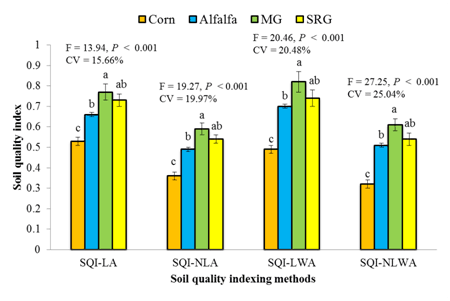As one of the most important natural resources, soil can provide sufficient material and energy for human survival and development, and its quality is directly related to regional ecological security and sustainable development of social economy. Land use and management practices have a very important impact on many soil ecological processes, which often determine the change degree and direction of soil quality. As an extremely sensitive and fragile soil resource, saline-alkali soilscan be influenced much easier by land uses than other soil types. However, the influences of land use conversions on soil quality and function are rarely quantified in alkaline soils.
Conversion of cropland to a vegetation covered land is commonly used as an efficient land use to recover degraded agricultural ecosystems worldwide. Based on a short-term land use experiment in Songnenplain, Research Group of Grassland Farming in IGA investigate the effects of four land uses with different vegetation covered, corn cropland (Corn), alfalfa forage land (Alfalfa), monocultureLyemuschinensisgrassland (AG) and regrowth grassland (RG), on the changes of soil quality.
Results indicated that re-vegetation has a positive effect on the improvement of most soil quality indicators, and the indicators of invertase, N:P ratio, water-extractable organic carbon and labile carbon arethe key indicators controlling soil quality in Songnen plain. Although the four developed SQIs quantify the influences of land uses on soil quality equally well regarding both sensitivity and accuracy, the SQI calculated using the non-linear weighted additive integration have the best discrimination due to the higher F values and larger coefficient of variance as compared to the other SQIs.Compared with Corn, value of soil quality index under Alfalfa, AG and RG treatment increase by 59.4%, 90.6% and 68.8%, respectively, indicating soil quality can be expected to gradually recover in northeastern China through re-vegetation.

Fig. 1 Comparison of soil quality indices under different land uses
Reference:
1. Yu P.J., Liu S.W., Zhang L., Li Q., Zhou D.W. Selecting the minimum data set and quantitative soil quality indexing of Alkali soils under different land uses in northeastern China. Science of the Total Environment, 2018, 616-617: 564-571.
2. Yu P.J., Liu S.W., Yang H.T., Fan G.H., Zhou D.W. Short-term land use conversions influence the profile distribution of soil salinity and sodicity in northeastern China. Ecological Indicators, 2018, 88: 79-87.
3. Yu P.J., Liu S.W., Han K.X., Guan S.C., Zhou D.W. Conversion of cropland to forage land and grassland increases soil labile carbon and enzyme activities in northeastern China. Agriculture, Ecosystems and Environment, 2017, 245: 83-91.
4. Yu P.J., Han K.X., Li Q., Zhou D.W. Soil organiccarbon fractions are affected by different land uses in an agro-pastoral transitional zone in Northeast China. Ecological Indicators, 2017, 73: 331-337.
Contact:
Yu Pujia, Ph.D.
Northeast Institute of Geography and Agroecology, Chinese Academy of Sciences
Tel:18743189268
E-mail: yupujia@iga.ac.cn